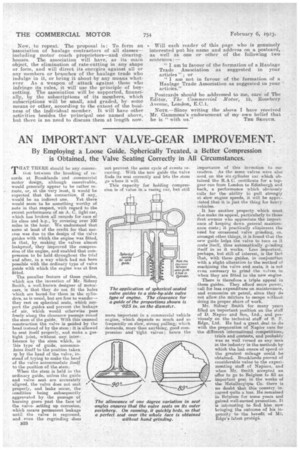AN IMPORTANT VALVE-GEAR IMPROVEMENT.
Page 12

If you've noticed an error in this article please click here to report it so we can fix it.
By Employing a Loose Guide, Spherically Treated, a Better Compression is Obtained, the Valve Seating Correctly in All Circumstances.
TAT THERE should be any connection between the breaking of records at Brooklands and commercial motor design, although conceivable, would generally appear to be rather remote, or, at the very least, it would be expected that the connection, if any, would be an indirect one. Yet there would seem to be something worthy of note in that respect, with regard to the recent performance of an A.. C. light ear, which has broken all records for cars of its class and h.p., by covering over 100 miles in the hour. We understand that some at least of the credit for that success was due to the design of the valve guides with which the engine was fitted, in that, by making the valves almost leakproof,, they improved the compression of the engine, and enabled that compression to be held throughout the trial and after, in a way which had not been possible with the ordinary type of valve guide with which the engine was at first fitted.
The peculiar feature of these guides, which are the invention of Mr. Sidney Smith, a well-known designer of motorcars, is that they do not fit the holes which are boredfor them in the cylinders, as is usual, but are free to wander— they rest on spherical seats, which 30pport the guides and prevent the leakage of air, which would otherwise pass freely along the clearance passage round the stem of the, guide. With this unusual construotion the valve is guided by the head instead of by the stem : it is allowed to seat itself properly, and make a gastight joint, without any interference by the stem which, in this type of guide, accommodates itself to tte position taken ip by the head of the valve, instead of trying to make the head of the. valve accommodate itself to the position of the stem.
When the stem is held in the ordinary guide, unless the guide and valve seat are accurately aligned, the valve does not seat properly, and leaks occur, the condition being subsequently aggravated by the passage of burning gases past the face of the valve. setting up corrosion, :which means permanent leakage until the valve is reground, and, even the regrinding does 1328
not prevent the same cycle of events recurring. With the new guide the valve finds its seat correctly and lets the stern go where it will.
This capacity for holding compression is of value in :a racing ear, but still more important in a commercial vehicle engine, which depends so much and so frequently on slow, strong pulling, which demands, more than anything, good compression and tight valves; hence the
importance of this invention to our leaders. As the same valves were also wed on the six-ca,lincler car which, obtained the R.A C. certificate for a topgear run from London to Edinburgh and hack, a performance which obviously calls for the ability to pull strongly at, slow engine speeds, it will be appra• aiated that it is just the thing for heavy vehicles.
It has another property which must also make its appeal, particularly to those fleet owners who appreciate the importance of keeping down general maintenance costs; it practically eliminates the need for occasional valve grinding, as, amongst other things, it is found that the new guide helps the valve to turn as it i..:eats itself, thus automatically grinding itself in as it works. Less important, perhaps, but still of interest, is the fact that, with these guides, in conjunction with a slight alteration to the method of machining the valve and seats, it is not even necessary to grind the valves in when they are fitted to the new engine.
There is therefore a triple appeal in these guides. They afford more power, call for less expenditure on-maintenance; and economize on petrol, since they do not allow,the mixture to escape without doing its proper share a work.
Mr. Sidney Smith for many years filled an important position on the staff of B. Napier and Son, Ltd., and pre. viouily on the. technical staff of S. F. Edge, Ltd. He had a great deal to do with the preparation of Napier cars for the different international competitions,. trials and contests, and probably was as well versed as any man in the industry in the methods by which the last ounce of speed-or the greatest mileage could beobtained. Brooklands proved of • considerable value to the experimenting staff of Napiers, and when Mr. Smith accepted an offer to go to Belgium to fill an important. post in the works of the Metallurgique Co. there is no doubt that this country incurred quite a loss. He remained in Belaium for some years and gained well-earned promotion. It is interesting to find him now bringing the outcome of his ingenuity to the benefit of Mr. Edge's latest protege.




























